数字化变电站研究-参考文献及英文文献
- 格式:pdf
- 大小:179.73 KB
- 文档页数:6
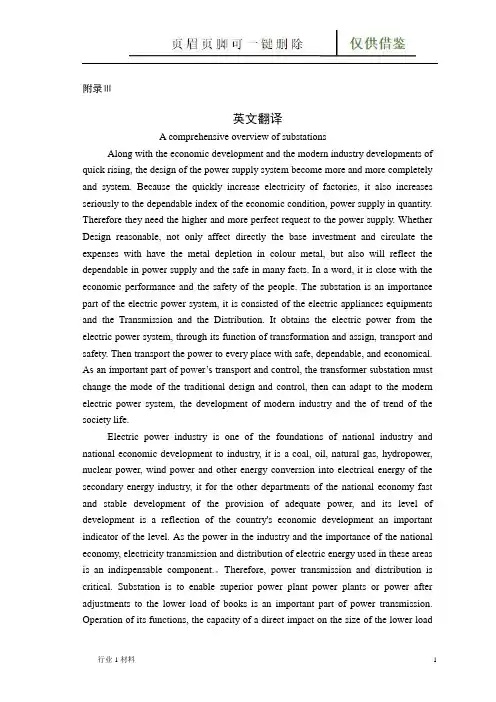
附录Ⅲ英文翻译A comprehensive overview of substationsAlong with the economic development and the modern industry developments of quick rising, the design of the power supply system become more and more completely and system. Because the quickly increase electricity of factories, it also increases seriously to the dependable index of the economic condition, power supply in quantity. Therefore they need the higher and more perfect request to the power supply. Whether Design reasonable, not only affect directly the base investment and circulate the expenses with have the metal depletion in colour metal, but also will reflect the dependable in power supply and the safe in many facts. In a word, it is close with the economic performance and the safety of the people. The substation is an importance part of the electric power system, it is consisted of the electric appliances equipments and the Transmission and the Distribution. It obtains the electric power from the electric power system, through its function of transformation and assign, transport and safety. Then transport the power to every place with safe, dependable, and economical. As an important part of power’s transport and control, the transformer substation must change the mode of the traditional design and control, then can adapt to the modern electric power system, the development of modern industry and the of trend of the society life.Electric power industry is one of the foundations of national industry and national economic development to industry, it is a coal, oil, natural gas, hydropower, nuclear power, wind power and other energy conversion into electrical energy of the secondary energy industry, it for the other departments of the national economy fast and stable development of the provision of adequate power, and its level of development is a reflection of the country's economic development an important indicator of the level. As the power in the industry and the importance of the national economy, electricity transmission and distribution of electric energy used in these areas is an indispensable component.。
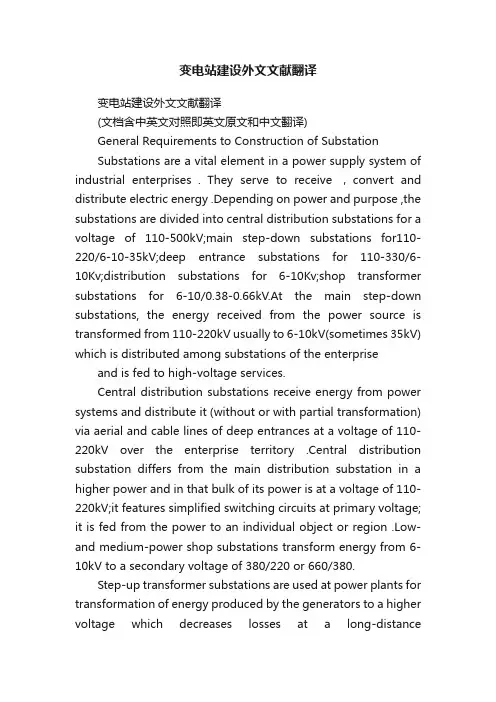
变电站建设外文文献翻译变电站建设外文文献翻译(文档含中英文对照即英文原文和中文翻译)General Requirements to Construction of SubstationSubstations are a vital element in a power supply system of industrial enterprises.They serve to receive ,convert and distribute electric energy .Depending on power and purpose ,the substations are divided into central distribution substations for a voltage of 110-500kV;main step-down substations for110-220/6-10-35kV;deep entrance substations for 110-330/6-10Kv;distribution substations for 6-10Kv;shop transformer substations for 6-10/0.38-0.66kV.At the main step-down substations, the energy received from the power source is transformed from 110-220kV usually to 6-10kV(sometimes 35kV) which is distributed among substations of the enterprise and is fed to high-voltage services.Central distribution substations receive energy from power systems and distribute it (without or with partial transformation) via aerial and cable lines of deep entrances at a voltage of 110-220kV over the enterprise territory .Central distribution substation differs from the main distribution substation in a higher power and in that bulk of its power is at a voltage of 110-220kV;it features simplified switching circuits at primary voltage; it is fed from the power to an individual object or region .Low-and medium-power shop substations transform energy from 6-10kV to a secondary voltage of 380/220 or 660/380.Step-up transformer substations are used at power plants for transformation of energy produced by the generators to a higher voltage which decreases losses at a long-distancetransmission .Converter substations are intended to convert AC to DC (sometimes vice versa) and to convert energy of one frequency to another .Converter substations with semiconductor rectifiers are convert energy of one frequency to another .Converter substations with semiconductor rectifiers are most economic. Distribution substations for 6-10kV are fed primarily from main distribution substations (sometimes from central distribution substations).With a system of dividing substations for 110-220kV, the functions of a switch-gear are accomplished by switch-gears for 6-10kV at deep entrance substations.Depending on location of substations their switch-gear may be outdoor or indoor. The feed and output lines at 6-10kV substations are mainly of the cable type .at 35-220kV substations of the aerial type .When erecting and wiring thesubstations ,major attention is given to reliable and economic power supply of a given production.Substations are erected by industrial methods with the use of large blocks and assemblies prepared at the site shops of electric engineering organizations and factories of electrical engineering industry .Substations are usually designed for operation without continuous attendance of the duty personnel but with the use of elementary automatic and signaling devices.When constructing the structural part of a substation .it is advisable to use light-weight industrial structures and elements (panels ,floors ,etc.) made of bent sections .These elements are pre-made outside the erection zone and are only assembled at site .This considerably cuts the terms and cost of construction.Basic circuitry concepts of substations are chosen when designing a powersupply system of the enterprise .Substationsfeature primary voltage entrances .transformers and output cable lines or current conductors of secondary voltage .Substations are mounted from equipment and elements described below .The number of possible combinations of equipment and elements is very great .Whenelaborating a substation circuitry ,it is necessary to strive for maximum simplification and minimizing the number of switching devices .Such substations are more reliable and economic .Circuitry is simplified by using automatic reclosure or automatic change over to reserve facility which allows rapid and faultless redundancy of individual elements and using equipment.When designing transformer substations of industrial enterprises for all voltages ,the following basic considerations are taken into account:1. Preferable employment of a single-bus system with using two-bus systems only to ensure a reliable and economic power supply;2. Wide use of unitized constructions and busless substations;3.Substantiated employment of automatics and telemetry ;if the substation design does not envisage the use of automatics or telemetry ,the circuitry is so arranged as to allow for adding such equipment in future without excessive investments and re-work./doc/554c0a220622192e453610661ed9ad5 1f01d5431.html e of simple and cheap devices-isolating switches ,short-circuiting switches ,load-breaking isolators ,fuses ,with due regard for their switching capacity may drastically cut the need for expensive and critical oil ,vacuum ,solenoid and air switches .Substation and switch-gear circuitries are so made that using the equipment of eachproduction line is fed from individual transformers ,assemblies ,the lines to allow their disconnection simultaneously with mechanisms without disrupting operation of adjacent production flows.When elaborating circuitry of a substation, the most vital task is to properly choose and arrange switching devices(switches ,isolators ,current limiters ,arresters ,high-voltage fuses).The decision depends on the purpose ,power and significance of the substation.Many years ago, scientists had very vague ideas about electricity. Many of them thought of it as a sort of fluid that flowed through wires as water flows through pipes, but they could not understand what made it flow. Many of them felt that electricity was made up of tiny particles of some kind ,but trying to separate electricity intoindividual particles baffled them.Then, the great American scientist Millikan, in 1909,astounded the scientific world by actually weighing a single particle of electricity and calculating its electric charge. This was probably one of the most delicate weighing jobs ever done by man,for a single electric particle weighs only about half of a millionth of a pound. To make up a pound it would take more of those particles than there are drops of water in the Atlantic Ocean.They are no strangers to us, these electric particles, for we know them as electrons. When large numbers of electrons break away from their atoms and move through a wire,we describe this action by saying that electricity is flowing through the wire.Yes,the electrical fluid that early scientists talked about is nothing more than electrical flowing along a wire.But how can individual electrons be made to break awayfrom atoms? And how can these free electrons be made to along a wire? The answer to the first question lies in the structure of the atoms themselves. Some atoms are so constructed that they lose electrons easily. An atom of copper, for example ,is continually losing an electron, regaining it(or another electron),and losing it again. A copper atom normally has 29 electrons, arranged in four different orbits about its nucleus. The inside orbit has 2 electrons. The next larger orbit has 8.The third orbit is packed with 18 electrons . And the outside orbit has only one electron.It is this outside electron that the copper atom is continually losing, for it is not very closely tied to the atom. It wanders off, is replaced by another free-roving electron, and then this second electron also wandersaway.Consequently,in a copper wire free electrons are floating around in all directions among the copper atoms.Thus, even through the copper wire looks quite motionless to your ordinary eye, there is a great deal of activity going on inside it. If the wire were carrying electricity to an electric light or to some other electrical device, the electrons would not be moving around at random. Instead, many of them would be rushing in the same direction-from one end of the wire to the other.This brings us to the second question .How can free electrons be made to move along a wire? Well ,men have found several ways to do that .One way is chemical. V olta,s voltaic pile,or battery, is a chemical device that makes electricity(or electrons)flow in wires. Another way is magnetic. Faraday and Henry discovered how magnets could be used to make electricity flow in a wire.MagnetsAlmost everyone has seen horseshoe magnets-so called because they are shaped like horseshoes. Probably you have experimented with a magnet, and noticed how it will pick up tacks and nails, or other small iron objects. Men have known about magnets for thousands of years.Several thousand years ago, according to legend, a shepherd named Magnes lived on the island of Crete, in the Mediterranean Sea .He had a shepherds crook tipped with iron. One day he found an oddly shaped black stone that stuck to this iron /doc/554c0a220622192e453610661ed9ad51f0 1d5431.html ter, when many other such stones were found, they were called magnets(after Magnets).These were natural magnets.In recent times men have learned how to make magnets out of iron. More important still, they have discovered how to use magnets to push electrons through wires-that is, how to make electricity flow. Before we discuss this, there arecertain characteristics of magnets that we should know about.If a piece of glass is laid on top of a horse- shoes magnet, and if iron filings are then sprink ledon the glass, the filings will arrange themselves into lines. If this same thing is trid with a bar magnet(a horseshoe magnet straightened out),the lines can be seen more easily. These experiments demonstrate what scientists call magnetic lines of force. Magnets, they explain, work through lines of force that ext- end between the two ends of the magnet. But electrons seem to have magnetic lines of force around them, too.This can be proved by sticking a wire through a piece ofcard board, sprinkling iron filings on the cardboard, and connecting a battery to the wire. The filings will tend to form rings around the wire,as a result of the magnetism of the moving electrons(or electricity).So we can see that there is arelationship betweenmoving electrons and magnetism, Magnetism results from the movement of electrons.Of course, electrons are not really flowing in the bar magnet, but they are in motion, circling the nuclei of the iron atoms. However, in the magnet, circling thelined up in such a way that their electrons are circling in the same direction. Perhaps a good comparison might be a great number of boys whirling balls onstrings in a clockwise direction around their heads.翻译:变电站建设的一般要求变电站(所)在电源系统的工业企业是一个至关重要的因素。
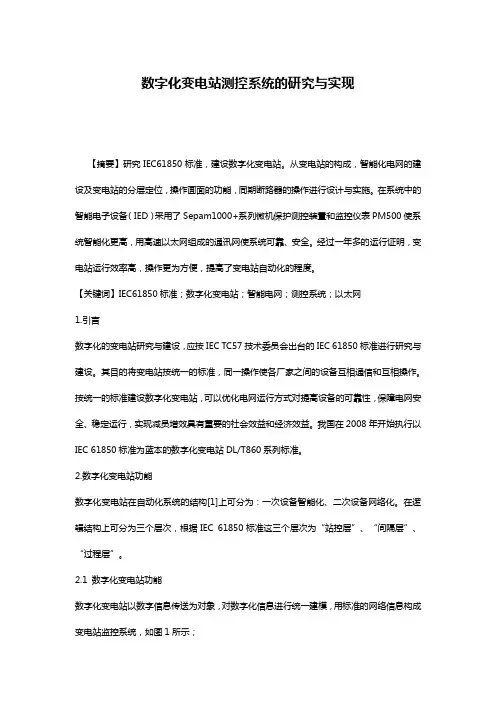
数字化变电站测控系统的研究与实现【摘要】研究IEC61850标准,建设数字化变电站。
从变电站的构成,智能化电网的建设及变电站的分层定位,操作画面的功能,同期断路器的操作进行设计与实施。
在系统中的智能电子设备(IED)采用了Sepam1000+系列微机保护测控装置和监控仪表PM500使系统智能化更高,用高速以太网组成的通讯网使系统可靠、安全。
经过一年多的运行证明,变电站运行效率高,操作更为方便,提高了变电站自动化的程度。
【关键词】IEC61850标准;数字化变电站;智能电网;测控系统;以太网1.引言数字化的变电站研究与建设,应按IEC TC57技术委员会出台的IEC 61850标准进行研究与建设。
其目的将变电站按统一的标准,同一操作使各厂家之间的设备互相通信和互相操作。
按统一的标准建设数字化变电站,可以优化电网运行方式对提高设备的可靠性,保障电网安全、稳定运行,实现减员增效具有重要的社会效益和经济效益。
我国在2008年开始执行以IEC 61850标准为蓝本的数字化变电站DL/T860系列标准。
2.数字化变电站功能数字化变电站在自动化系统的结构[1]上可分为:一次设备智能化、二次设备网络化。
在逻辑结构上可分为三个层次,根据IEC 61850标准这三个层次为“站控层”、“间隔层”、“过程层”。
2.1 数字化变电站功能数字化变电站以数字信息传送为对象,对数字化信息进行统一建模,用标准的网络信息构成变电站监控系统,如图1所示;2.2 站控层主要功能(1)将站内的两级高速网络的信息汇总的实时数据,信息不断更新实时数据库,按时登录历史数据库。
(2)将站内的有关数据、信息报送控制中心,同时将中心的有关指令下达到“间隔层”、“过程层”,进行执行。
(3)具有在线编成全站的操作控制功能,和在线对“间隔层”、“过程层”的维护,在线修改参数等。
(4)具有站内的监控、报警,变电站故障自动分析,操作学习的功能。
2.3 间隔层功能(1)承上启下的通信功能,完成“过程层”及“站控层”网络通信功能。
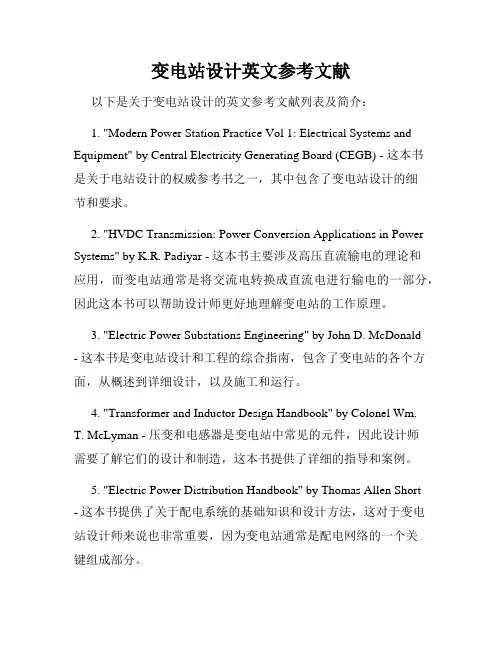
变电站设计英文参考文献以下是关于变电站设计的英文参考文献列表及简介:1. "Modern Power Station Practice Vol 1: Electrical Systems and Equipment" by Central Electricity Generating Board (CEGB) - 这本书是关于电站设计的权威参考书之一,其中包含了变电站设计的细节和要求。
2. "HVDC Transmission: Power Conversion Applications in Power Systems" by K.R. Padiyar - 这本书主要涉及高压直流输电的理论和应用,而变电站通常是将交流电转换成直流电进行输电的一部分,因此这本书可以帮助设计师更好地理解变电站的工作原理。
3. "Electric Power Substations Engineering" by John D. McDonald- 这本书是变电站设计和工程的综合指南,包含了变电站的各个方面,从概述到详细设计,以及施工和运行。
4. "Transformer and Inductor Design Handbook" by Colonel Wm. T. McLyman - 压变和电感器是变电站中常见的元件,因此设计师需要了解它们的设计和制造,这本书提供了详细的指导和案例。
5. "Electric Power Distribution Handbook" by Thomas Allen Short- 这本书提供了关于配电系统的基础知识和设计方法,这对于变电站设计师来说也非常重要,因为变电站通常是配电网络的一个关键组成部分。
6. "Switchgear and Protection" by J.B Gupta - 变电站中使用的开关设备和保护系统非常关键,这本书提供了涵盖相关主题的详细信息,包括故障和过电压保护,以及开关设备的选择和维护。

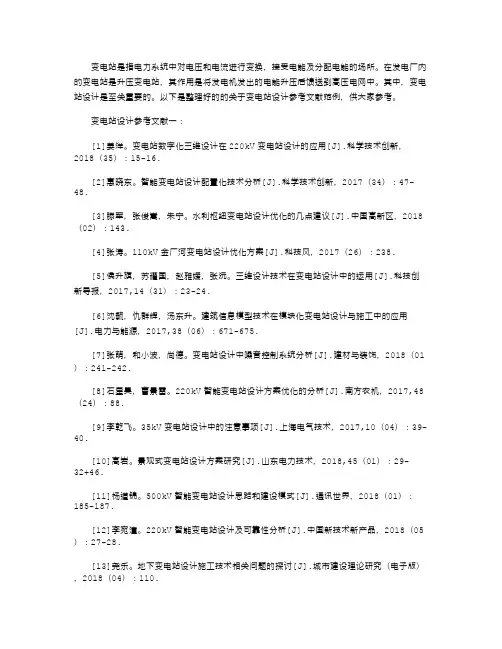
变电站是指电力系统中对电压和电流进行变换,接受电能及分配电能的场所。
在发电厂内的变电站是升压变电站,其作用是将发电机发出的电能升压后馈送到高压电网中。
其中,变电站设计是至关重要的。
以下是整理好的的关于变电站设计参考文献范例,供大家参考。
变电站设计参考文献一: [1]姜洋。
变电站数字化三维设计在220kV变电站设计的应用[J].科学技术创新,2018(35):15-16. [2]惠晓东。
智能变电站设计配置化技术分析[J].科学技术创新,2017(34):47-48. [3]滕军,张俊嵩,朱宁。
水利枢纽变电站设计优化的几点建议[J].中国高新区,2018(02):143. [4]张涛。
110kV金厂河变电站设计优化方案[J].科技风,2017(26):238. [5]侯升旗,苏耀国,赵雅媛,张沅。
三维设计技术在变电站设计中的运用[J].科技创新导报,2017,14(31):23-24. [6]沈毓,仇群辉,汤东升。
建筑信息模型技术在模块化变电站设计与施工中的应用[J].电力与能源,2017,38(06):671-675. [7]张萌,和小波,尚德。
变电站设计中噪音控制系统分析[J].建材与装饰,2018(01):241-242. [8]石星昊,曹景雷。
220kV智能变电站设计方案优化的分析[J].南方农机,2017,48(24):88. [9]李乾飞。
35kV变电站设计中的注意事项[J].上海电气技术,2017,10(04):39-40. [10]高岩。
景观式变电站设计方案研究[J].山东电力技术,2018,45(01):29-32+46. [11]杨道锦。
500kV智能变电站设计思路和建设模式[J].通讯世界,2018(01):185-187. [12]李宛潼。
220kV智能变电站设计及可靠性分析[J].中国新技术新产品,2018(05):27-28. [13]尧乐。
地下变电站设计施工技术相关问题的探讨[J].城市建设理论研究(电子版),2018(04):110. [14]宋祉明,张伟,徐肃,张轶,李智玲,付小平。

基于IEC61850数字化变电站的研究摘要变电站自动化技术的发展和微机保护的广泛应用极大地提高了电网的自动化水平和管理水平,但是由于变电站自动化系统和保护设备的通信协议不统一,造成系统无缝集成困难,生命周期缩短;设备之间互操作性差,维护工作量大,改造升级困难。
同时变电站的一、二次设备的控制信号发送、模拟量采集靠大量的电缆连接实现,不仅浪费了大量的财力,而且抗干扰性大大降低。
随着IEC61850 标准的发布,电子式互感器、智能化高压电气设备的发展,电气设备在线状态检测、变电站运行操作培训仿真等技术日趋成熟,以及计算机网络技术的高速发展,使得建设数字化变电站具备了必要的技术条件。
本文在研究数字化变电站相关理论和技术的基础上,总结变电站数字化技术的现状、发展趋势,初步形成数字化变电站的整体模型,提出了数字化变电站的特征和需要实现的功能。
研究数字化变电站三层网络结构下通信的实现,运用前面的研究成果,探讨在现有技数条件下建设数字化变电站,如何实现与以往设备的兼容,使本文提出的数字化变电站改造方案更具有实用性和可操作性。
关键词:数字化变电站,IEC61850 标准,电子式互感器,智能化高压电气设备DIGITAL SUBSTATION BASED ON IEC61850 RESEARCHABSTRACTWith the development of integrated substation automation technology and microprocessor-based protections,electrical power system automation is highly promoted. But the communication protocols among IEDs produced by different manufacturers are different,the SA system will not be integrated well.Also,IEDs from different manufacturers are difficult to achieve interoperability.Maintenance and upgrading such a SA system may cost much resource and time.In a substation,many cables made with copper are used to transmit control signal and analog data,so highly lower the anti-interference of a SA system. The IEC6185O standard electronic measurement transformers,intelligent control of high voltage electrical apparatus,computer network technology,etc,all these make it possible to build a digital substation. So,the thesis will study these key technologies and intelligence devices,and give a reference design project of digital substations. First,a digital substation model and main charaeters are formed in this thesis. Then a communication network construction principle of digital substations,including proeess buses and Station buses,are developed. According with the Principle,with the reaserch on the key technologies of 110kV wucun digital substation in Shenzhen Power Supply Bureau and 220kV sanxiang digital substation in nanfang Power Supply Bureau,this article analysis a digital substation’ s layered communication network framework. Deeply. Based on the investigation of intelligence devices of digital substations,selcetion and configuration principle of devices is summarized.KEY WORDS: digital subatation,IEC61850 standard ,electronictransformer ,intelligent control of high voltage electrical apparatus目录摘要 (I)ABSTRACT........................................................... I I 第1章绪论. (1)第2章数字化变电站系统的发展及现状 (3)2.1 变电站自动化系统的发展 (3)2.2 变电站自动化系统通信规约现状 (6)2.3 小结 (9)第3章数字化变电站的技术优势及经济效益 (10)3.1 数字化变电站的技术优势 (10)3.2 经济效益 (13)3.3 小结 (14)第4章 IEC61850 标准介绍 (15)4.1 IEC61850 标准主要内容 (15)4.1.1 IEC61850 标准内容 (15)4.2.1 分层 (17)4.2.2变电站通信网络的实时性以及时延不确定性研究 (18)4.3 本章小结 (35)总结与展望 (36)1.全文工作总结 (36)2. 工作展望 (37)致谢 (38)参考文献 (39)附录1 (43)第1章绪论变电站自动化系统是在计算机技术和网络通信技术基础上发展起来的。
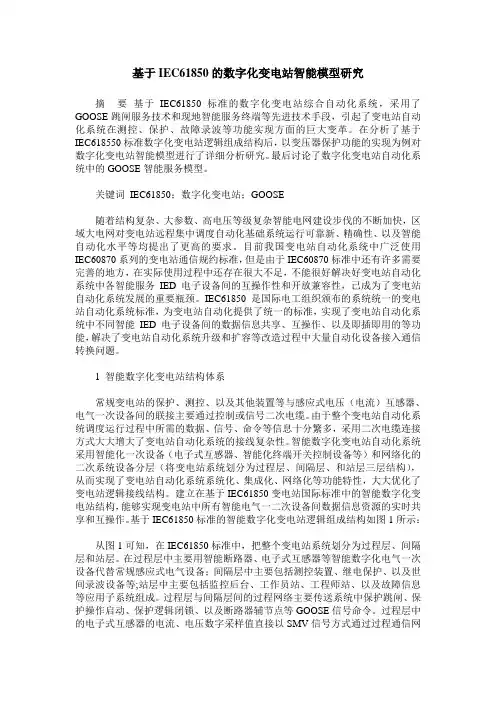
基于IEC61850的数字化变电站智能模型研究摘要基于IEC61850标准的数字化变电站综合自动化系统,采用了GOOSE跳闸服务技术和现地智能服务终端等先进技术手段,引起了变电站自动化系统在测控、保护、故障录波等功能实现方面的巨大变革。
在分析了基于IEC618550标准数字化变电站逻辑组成结构后,以变压器保护功能的实现为例对数字化变电站智能模型进行了详细分析研究。
最后讨论了数字化变电站自动化系统中的GOOSE智能服务模型。
关键词IEC61850;数字化变电站;GOOSE随着结构复杂、大参数、高电压等级复杂智能电网建设步伐的不断加快,区域大电网对变电站远程集中调度自动化基础系统运行可靠新、精确性、以及智能自动化水平等均提出了更高的要求。
目前我国变电站自动化系统中广泛使用IEC60870系列的变电站通信规约标准,但是由于IEC60870标准中还有许多需要完善的地方,在实际使用过程中还存在很大不足,不能很好解决好变电站自动化系统中各智能服务IED电子设备间的互操作性和开放兼容性,已成为了变电站自动化系统发展的重要瓶颈。
IEC61850是国际电工组织颁布的系统统一的变电站自动化系统标准,为变电站自动化提供了统一的标准,实现了变电站自动化系统中不同智能IED电子设备间的数据信息共享、互操作、以及即插即用的等功能,解决了变电站自动化系统升级和扩容等改造过程中大量自动化设备接入通信转换问题。
1 智能数字化变电站结构体系常规变电站的保护、测控、以及其他装置等与感应式电压(电流)互感器、电气一次设备间的联接主要通过控制或信号二次电缆。
由于整个变电站自动化系统调度运行过程中所需的数据、信号、命令等信息十分繁多,采用二次电缆连接方式大大增大了变电站自动化系统的接线复杂性。
智能数字化变电站自动化系统采用智能化一次设备(电子式互感器、智能化终端开关控制设备等)和网络化的二次系统设备分层(将变电站系统划分为过程层、间隔层、和站层三层结构),从而实现了变电站自动化系统系统化、集成化、网络化等功能特性,大大优化了变电站逻辑接线结构。
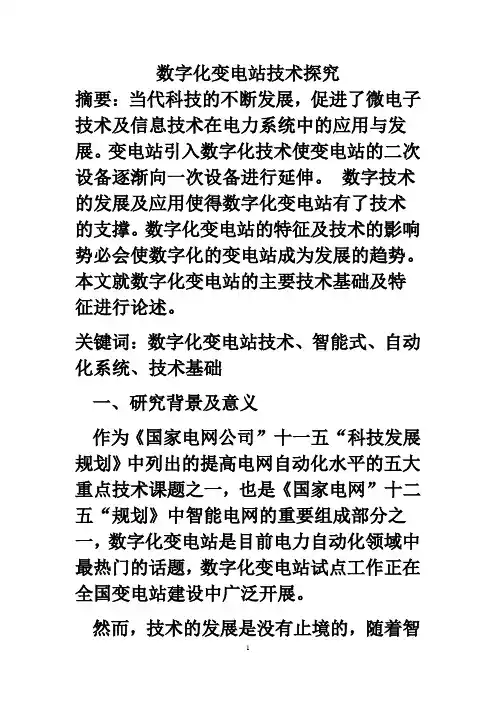
数字化变电站技术探究摘要:当代科技的不断发展,促进了微电子技术及信息技术在电力系统中的应用与发展。
变电站引入数字化技术使变电站的二次设备逐渐向一次设备进行延伸。
数字技术的发展及应用使得数字化变电站有了技术的支撑。
数字化变电站的特征及技术的影响势必会使数字化的变电站成为发展的趋势。
本文就数字化变电站的主要技术基础及特征进行论述。
关键词:数字化变电站技术、智能式、自动化系统、技术基础一、研究背景及意义作为《国家电网公司”十一五“科技发展规划》中列出的提高电网自动化水平的五大重点技术课题之一,也是《国家电网”十二五“规划》中智能电网的重要组成部分之一,数字化变电站是目前电力自动化领域中最热门的话题,数字化变电站试点工作正在全国变电站建设中广泛开展。
然而,技术的发展是没有止境的,随着智能化开关、光电式电流电压互感器、一次运行设备在线状态检测、变电站运行操作培训仿真等技术日趋成熟,以及计算机高速网络在实时系统中的开发应用,势必对已有的变电站自动化技术产生深刻的影响,全数字化的变电站自动化系统即将出现。
数字化变电站的建成投产将为电网数字化奠定基础,在变电站发展历程史上具有划时代的意义,是变电技术的革命。
二、数字化变电站的技术特征当前的数字化变电站主要通过电子式互感器、智能化的开关等数字化的一次设备、网络化的二次设备分层组成,在IEC61850通信规范的基础之上逐步实现变电站系统不断信息化、自动化智能化等要求。
首先,变电站中的电气设备信息通过数字化技术可以实现相互间的资源共享及利用,使操作更加便捷,同时减少变电站相关设备退出的次数及时间,减少了损耗,提高了设备的使用时间,对于自动化设备的数量进行精简,极大的简化了变电站的二次接线,提高变电站设备使用系统的可靠性,维护及及时更新扩展变电站中的设备功能。
其次,逐步实现了变电站信息在其系统运行过程中和其它支持的系统之间的信息共享,减少了资源重复建设,有利于投资成本的回收并延长变电站的使用年限。
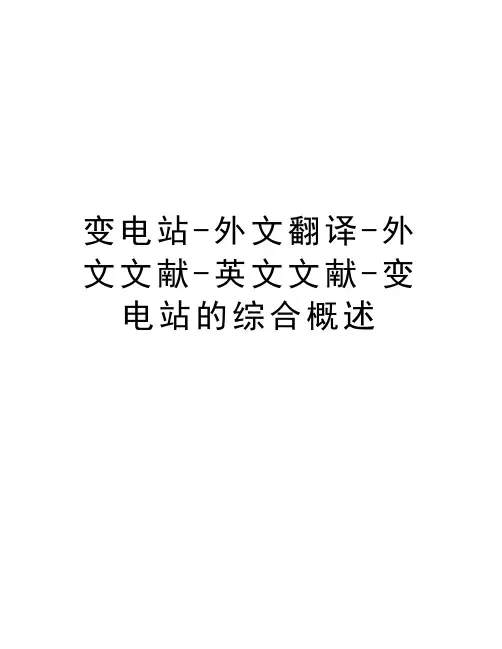
变电站-外文翻译-外文文献-英文文献-变电站的综合概述英文翻译A comprehensive overview of substationsAlong with the economic development and the modern industry developments of quick rising, the design of the power supply system become more and more completely and system. Because the quickly increase electricity of factories, it also increases seriously to the dependable index of the economic condition, power supply in quantity. Therefore they need the higher and more perfect request to the power supply. Whether Design reasonable, not only affect directly the base investment and circulate the expenses with have the metal depletion in colour metal, but also will reflect the dependable in power supply and the safe in many facts. In a word, it is close with the economic performance and the safety of the people. The substation is an importance part of the electric power system, it is consisted of the electric appliances equipments and the Transmission and the Distribution. It obtains the electric power from the electric power system, through its function of transformation and assign, transport and safety. Then transport the power to every place with safe, dependable, and economical. As an important part of power’s transport and control, the transformer substation must change the mode of the traditional design and control, then can adapt to the modern electric power system, the development of modern industry and the of trend of the society life.Electric power industry is one of the foundations of national industry and national economic development to industry, it is a coal, oil, natural gas, hydropower, nuclear power, wind power and other energy conversion into electrical energy of the secondary energy industry, it for the other departments of the national economy fast and stable development of the provision of adequate power, and its level of development is a reflection of the country's economic development an important indicator of the level. As the power in the industry and the importance of the national economy, electricity transmission and distribution of electric energy used in these areas is an indispensable component.。
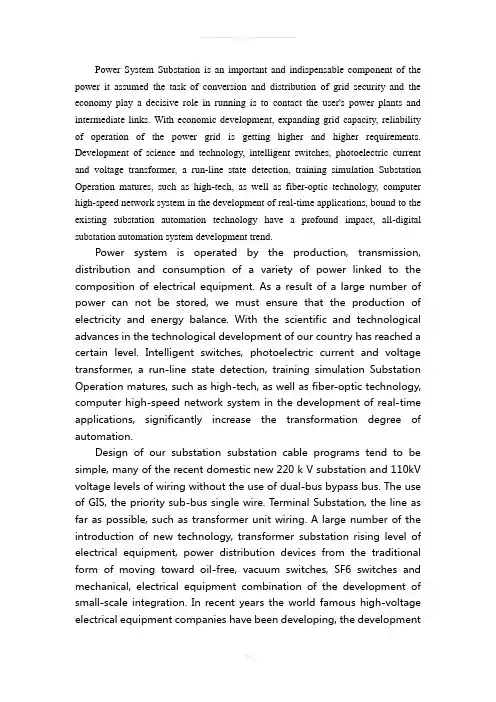
Power System Substation is an important and indispensable component of the power it assumed the task of conversion and distribution of grid security and the economy play a decisive role in running is to contact the user's power plants and intermediate links. With economic development, expanding grid capacity, reliability of operation of the power grid is getting higher and higher requirements. Development of science and technology, intelligent switches, photoelectric current and voltage transformer, a run-line state detection, training simulation Substation Operation matures, such as high-tech, as well as fiber-optic technology, computer high-speed network system in the development of real-time applications, bound to the existing substation automation technology have a profound impact, all-digital substation automation system development trend.Power system is operated by the production, transmission, distribution and consumption of a variety of power linked to the composition of electrical equipment. As a result of a large number of power can not be stored, we must ensure that the production of electricity and energy balance. With the scientific and technological advances in the technological development of our country has reached a certain level. Intelligent switches, photoelectric current and voltage transformer, a run-line state detection, training simulation Substation Operation matures, such as high-tech, as well as fiber-optic technology, computer high-speed network system in the development of real-time applications, significantly increase the transformation degree of automation.Design of our substation substation cable programs tend to be simple, many of the recent domestic new 220 k V substation and 110kV voltage levels of wiring without the use of dual-bus bypass bus. The use of GIS, the priority sub-bus single wire. T erminal Substation, the line as far as possible, such as transformer unit wiring. A large number of the introduction of new technology, transformer substation rising level of electrical equipment, power distribution devices from the traditional form of moving toward oil-free, vacuum switches, SF6 switches and mechanical, electrical equipment combination of the development of small-scale integration. In recent years the world famous high-voltage electrical equipment companies have been developing, the developmentof the various types of 145-550 kV outdoor high-pressure and ultrahigh-pressure combination of electrical appliances, some high-voltage switchgear plant has also started production of 145 k V compact outdoor portfolio electrical appliances. Smart plug-in type outdoor switchgear is a more complete high-pressure and ultrahigh-pressure switch system, which includes electrical first and second equipment, as well as the associated fiber optic cable, such as plug-type compound. The entire distributed substation automation system; the introduction of advanced network technology; substation and the construction area covers an area of reduced substation program to simplify wiring, switchgear, bus and steel pipes, such as the use of stents to substation layout is more simple, the abolition of the former station area and optimize the layout to make a substantial decline in an area substation.With technological advances, the traditional relay protection devices are gradually being replaced by microprocessor-based protection. Microprocessor-based protection is referred to as the protection of PC computer, a digital relay protection, is based on the programmable digital circuit technology and real-time digital signal processing technology of the Power System Protection. At present, both at home and abroad have been developed to 32-bit digital signal processor for hardware-based protection, control, measurement, and data communications integration of microprocessor-based protection control devices, and artificial intelligence technology into a number of relay protection, such as artificial neural networks, fuzzy theory to determine the realization of fault type, fault location, the direction of protection, the main equipment and other new methods of protection. By means of wavelet analysis of the theory of digital signal failure of the entire frequency band information and to achieve fault detection. These artificial intelligence technology to improve the accuracy of failure to provide a means of identification, but also some single-frequency signal based on the traditional method difficult to identify the problems to be resolved. At present, the microprocessor-based relay protection is along the microprocessor-based protection network, and intelligent, adaptiveand protection, control, measurement, signal, data communications integration direction.译文:变电站是电力系统中不可缺少的重要组成部分,它担负着电能转换和分配的任务,对电网的安全和经济运行起着举足轻重的作用,是联系发电厂和用户的中间环节。
变电站设计英文参考文献Design of Substations1. IntroductionThe design of substations plays a crucial role in the reliable and efficient operation of power systems. Substations are the key nodes in the transmission and distribution network, where electrical energy is converted, controlled, and distributed to meet the demands of consumers. This paper aims to discuss various aspects of substation design, covering layout, equipment selection, protection systems, grounding, and communication.2. Layout DesignThe layout design of substations includes determining the type, number, and arrangement of equipment, as well as the physical arrangement of the substation. The layout should consider factors such as ease of maintenance, safety, operational efficiency, and future expansion. The equipment may include transformers, circuit breakers, switches, relays, busbars, and meters. Computer-aided design tools have become essential in the layout design process, enabling engineers to optimize space utilization and minimize interference between different components.3. Equipment SelectionThe selection of equipment in substations is based on various factors, including voltage levels, load requirements, and system specifications. Transformers are an essential component, converting voltage levels between transmission and distribution networks. Different types of circuit breakers, such as air, oil, vacuum, or SF6, are selected based on their interrupting capacityand reliability. Switches and relays are used for circuit isolation and protection. The selection process also considers factors such as cost, availability, maintenance requirements, and environmental impact.4. Protection SystemsProtection systems are crucial in substation design to detect faults and protect equipment and personnel. These systems include various protective relays, fuses, and circuit breakers. Protective relays detect abnormal conditions, such as overcurrent, overvoltage, or insulation failure, and initiate the tripping of circuit breakers to isolate the faulted section. The coordination of protection settings is essential to ensure that only the faulty section is isolated and that the rest of the network remains operational.5. GroundingProper grounding is crucial for the safety and reliable operation of substations. The grounding system provides a low-impedance path for fault currents and helps stabilize voltage levels. It also helps in the detection and localization of ground faults. Different grounding techniques, such as solid grounding, resistance grounding, or low-resistance grounding, are selected based on the system requirements and the type of faults expected.6. CommunicationEffective communication systems are essential in substations for remote monitoring, control, and troubleshooting. Communication networks can be wired or wireless, depending on the specific requirements and coverage area. Supervisory Control and Data Acquisition (SCADA) systems are often used to collect andanalyze data, monitor equipment status, and control substation operations. The implementation of state-of-the-art communication technologies, such as optical fibers and wireless networks, greatly enhances the reliability and efficiency of substation operations.In conclusion, the design of substations involves careful consideration of layout, equipment selection, protection systems, grounding, and communication. The integration of advanced technologies and computer-aided design tools has significantly improved the efficiency, reliability, and safety of substation designs. Ongoing research and development in this field continue to enhance the performance and capabilities of substations in meeting the increasing demands of power systems.。
分类号学号学校代码10487 密级硕士学位论文IEC61850数字变电站综合自动化系统学位申请人:学科专业:电力系统及其自动化指导教师:教授答辩日期:年月日A Thesis Submitted in Partial Fulfillment of the Requirementsfor the Degree for the Master of EngineeringDIGITAL SUBSTATION COMPREHENSIVEAUTOMATION SYSTEM OVER IEC61850Candidate : Wang canMajor : Power System and its AutomationSupervisor : Prof. Liu PeiHuazhong University of Science & TechnologyWuhan 430074, P.R.ChinaMay, 2009独创性声明本人声明所呈交的学位论文是我个人在导师指导下进行的研究工作及取得的研究成果。
尽我所知,除文中已经标明引用的内容外,本论文不包含任何其他个人或集体已经发表或撰写过的研究成果。
对本文的研究做出贡献的个人和集体,均已在文中以明确方式标明。
本人完全意识到本声明的法律结果由本人承担。
学位论文作者签名:日期:年月日学位论文版权使用授权书本学位论文作者完全了解学校有关保留、使用学位论文的规定,即:学校有权保留并向国家有关部门或机构送交论文的复印件和电子版,允许论文被查阅和借阅,本人授权华中科技大学可以将本学位论文的全部或部分内容编入有关数据库进行检索,可以采用影印、缩印或扫描等复制手段保存和汇编本学位论文。
保密□,在年解密后适用本授权书。
本论文属于不保密□。
(请在以上方框内打“√”)学位论文作者签名:指导教师签名:日期:年月日日期:年月日摘要随着非常规互感器逐步在工程中代替传统电磁互感器运行,IEC61850标准的颁布及其对信息的统一建模,高速以太网技术构建的变电站数据采集及传输系统的应用、智能化断路器技术的发展等,数字化变电站及数字化电网概念正被逐步提出。
110 kV substations digital transformation case analysis [Abstract]This paper briefly introduces the basic concept of digital substation, Analysised substation digitization reconstruction examples based on 110 kV substations.A detailed analysised of the substation secondary equipment such as changes in operating mode. Digital Substation discussed possible options for reform, and according to the results of the operation of digital substation work out countermeasures and Recommended.[Key words] digital substation; automation; Electronic TransformerWith automation and computer network traffic monitoring and protection technology, the rapid development in Past two decades has made substantial progress has been achieved for the digital substation automation system . Network laid the technical foundation for fulfilling the other hand, with the special high-voltage large-capacity .The gradual formation of large scale grid, the grid stable and reliable control of the safety information exchange ,And put forward higher requirements of the urgent. Digital Substation substation construction will be Trends .1. the characteristics of digital substationThe basic features of digital substation can be summarized as: intelligent primary equipment, secondary equipment network, automated operation and management system. Since the station relative to conventional integrated, digital substation equipment, the protective principle, the internal algorithm, logic has not fundamentally changed, but in sampling digital, networked communication medium, communication interface standardization brought changes to improve the reliability of substation automation system. Reliability of information transmission can be achieved; secondary wiring is simple; measurement accuracy; share unified information platform, reduce duplication of equipment; easy functionality expansion; management automation.2. 110 kV Substation rehabilitation programs1) a part of. 110kV single busbar sub-main wiring methods, 110kV line 3 times, witha standby power source; the main volume into 2 sets of 3 variables; 35kV main connection method for the Single Bus, 35kV line 5 back; 10kV main connection is a single busbar way, 2 sets of capacitors, 10kV line 18 back, 2 sets of ground change, the replacement of transformers for the electronic, installation of PT parallel combiner; replacement in situ terminal box, installation switches intelligent unit, to achieve local control switch ; configuration integrated digital protection monitoring devices and digital power meter, equipped with digital standby power source device, care monitoring devices and focus group screen interval of combiner.2) station control layer. Station control layer consists of a units monitoring host, 2 Machines GPS communications management component to form the station control level star network, monitoring the host machine automatically selects the host communication management, communication management unit and the interval as an independent link layer device, and the bay level devices communication, access to remote, telemetry data, only the host with the remote authority, communication management unit interval of five anti-blocking cross-sequence and function of smallcurrent grounding line, for the interval layer and process layer device when the hard right.3) spacer. Interval layer is the core of the station automation, communications related to the implementation of the process level GOOSE 35kV, 10kV lines, capacitors, ground change, sub-protective and monitoring local installation; 110kV Main Transformer Protection and Control focus group back screen, installed in the control Room, located optical interface screen, providing the distance to the control room of the optical conversion interface; three sides of the main transformer backup protection one, 110kV segmentation and one prepared from the cast; monitoring interface communication, lockout protection association; private GOOSE network to achieve important, the key trip control, station control layer GOOSE network, to achieve control of auxiliary tripping minor, such as the low cycle load shedding.4) the process level. Parallel combination provides voltage voltage, the output interval of combiner to provide the voltage signal; the main transformer and back of each side of the differential transformer is divided into, setting separate combiner, combiner transformer transformer protection group in the main screen; 110kV line segment combiner configured individually, group within the control room screen line combiner; 35kV 10kV PT 1 set of each combiner configured to achieve PT parallel functions; arranged in the sub-cabinet; 35kV 10kV part of the access by small-signal combiner, arranged in switch cabinet.5) communication network. a. station control station control interlayer layer network layer network: set a switch, the Internet communications management unit monitoring host dual GPS; interval layer network: at 10kV I Section II Section were placed on a switch, 35kV put a switch in paragraph , the main cabinet to set up a communications switch, focus group screen spacer device to the communications network of the main cabinet b. the process level, GOOSE private network. Process layer network: electronic transformer CT interval of combiner access, electronic access to the voltage transformer PT merger, voltage output access interval of combiner combiner; GOOSE Network: ring network composed of 1 # Main Variable interval Protection and Control and smart cell group into a RSG2100, 2 # Main Transformer Protection and Control and intelligence unit interval group into another RSG2100, 110kV line interval of Protection and Control and intelligence unit set into another RSG2100, composed of a single inter-switch interconnect ring.6) After the transformation of the substation has the advantage. a. back-office system integration, are in compliance with requirements of the secondary consolidation; b. with 61850 protocol, consistency, and simple interface without a lot of signal cable installation and commissioning work is small, can reduce the cost of maintenance and renovation; c. use of electronic CT / PT, non-core, eliminating the magnetic saturation; to avoid the CT open circuit, earth fault in the secondary circuit problems; d. long-distance transmission of digital signals using optical fiber, anti-interference ability, reducing the transmission error; of nearly still use the hard-wiring from the transmission, reducing the number of devices to simplify structure.3. substations protection equipment remote monitoring and management systems analysis and design1) substation protection equipment remote monitoring and management systemThe system for power companies to protect management's application requirements designed to protect the department aims to provide a management and maintenance of station equipment platform, the system should meet the following features: timely, accurate collection of station equipment, real-time information; accurate monitoring of all setting relay station changes, and timely warning; comprehensive management of all the relay stations recorded data; provides engineers easy access to any virtual channels to all relay stations; provide a friendly user interface for maintenance and management; Accurate and fast data retrieval and query; high level of security, strict management of operating authority and provides audit function; system has a high scalability, maintainability; system is stable, safe and reliable; good man-machine interface According to the actual needs of the application of the hierarchical principle and open systems, the whole system is divided into enterprise application layer, service layer, station control management and equipment level.Station control stations relay data subsystem is responsible for the collection, processing, valuation and management functions include the following modules: RTDB: RealTime Database, real-time data management, systems management as the core of the system responsible for managing all of the real time data, events, police records; HMI: HumanMachine Interface, local display and control management; DCAl03: DataCollectionApplicationwithIECl03, IECl03 communications processing, complete with support IECl03 relay communications between the Statute, to collect real-time data sent to relay real-time database; as Support 103 for the relay setting and recorded data, the corresponding value for management; Courier: CourierDCA communications processing, complete with relay communication between the relay real-time data collection, event data, protection setting , recorded data; Modbus: ModbusDCA Statute of the communication processing; DNP30: DNP3.0 DCA Statute of the data processing; GD8Calc: GD8-line basis, to provide advanced automatic calculation and automatic control functions; VC: Virtual Connection Manager, providing a virtual channel with the server connection and, if necessary, send a request to the DCA loan communication channel; DNPDPA: DPA (DataProces sApplication) type applications, communicate with the server through DNP3.0 statute. This subsystem is responsible for the data collection points, and saved to the server SQLServer database, including the following modules: DC: DataCollection application station control subsystem is responsible for communication and exchange through the DNP3 0 real-time data and event data, and to the real-time data; RTDB: real-time data management, including real-time data management, and a variety of real-time data access interface (shared memory TCP IP database), and save the historical database, to provide lock control; user management: Manage user roles, password, operating privilege, etc.; role management, managerial role and define the appropriate authority; configuration management: management station data and communication within the parameters and alarm configuration (SMS GSM EMAIL); graphics production system: user-defined interface production system; virtual serial port, virtual channel dynamic management; event query Modules: Alarm query module, the station data query module: check the communication relay stations withinthe state of constant change state, recorded data; constant query module; Virtual Connect modules; single line diagram: a graphical user interface provides real-time data Display operation control, etc.; historical data query; audit module; operational records check.2) database design systemMonitoring and management system for the protection of the core is around the station designed to protect the information data, the database design directly related to the effect and operation of the whole system performance, while the database system to other computer systems, with more objects, longer survival data, with high requirements on the maintenance and security of the information related to such issues, so the database design must be carefully and cautiously database design for this system, we propose the following four basic priiples to guide the design of the database :a, try to ensure the simplicity of the database, including: simple database structure, data sheets and data sheet design simple relationship between Q and other simpleb, to ensure the integrity of database systems, including: the physical integrity of the database system, database, logical integrity, the integrity of the elements of the database systemc, to ensure the confidentiality of the database system, including: the database system, the user identity and authority to identify, to ensure that each user and their access to the system is legitimate and can be identified in the design of the time so we can the body of the user identification and access rights to control the system provides the user can only operate within the purview and ensure the security of system datad, to ensure the availability of database systems, which ensure that the database can access system resources, easy to use and to avoid data conflicts in the data access process, to ensure no conflict between the data and contradictions in this system, the server database used relational database, and use Microsoft's SQL2005Server name of the database design is MinilPACS, stored data are historical data configuration information and event information data, user information configuration data using MS Acces s database, download the station controlled by synchronizing Equipment GD8 can be converted into the CDB CE data formats, and through the papers to copy or synchronize GD84. the operation of digital substationDigital substation system to achieve the full hierarchical distributed application; first and second device to achieve effective electrical isolation, interoperability between devices; information integration has increased, reduce the number of automation equipment; station electrical quantities collected United blocking signal transmission and equipment trip command to run all through the fiber optic networks; has a higher than conventional automation system reliability, availability, security; substation automation system is to ensure that primary and secondary equipment, the normal operation of the core, daily operation and maintenance should be given more attention to the information prompted to run equipment; concern communication device alarm interrupt event log information tips; concerns real-time monitoring and control console prompt warning information; network communication interruption shouldcheck the device prompt the switch state of communication lines; case no display device, it should ascertain whether the loss of power outage, such as the reasons for withdrawal should be identified and then put into operation; after power should conduct a comprehensive inspection to confirm installation of the normal operation after running the program is another advantage of the current digital 110kV substation south of change remote operation can be achieved has been the general order of the control and operation (programmed operation) program of the operating system is pre-set through the automated process operation of the substation equipment series, issued by the operating instructions is to grant an order by the automated system based on equipment corresponding changes in the amount of remote telemetry to determine the letter of each step is in place, the case confirmation in place the next step, otherwise the alarm.Conclusion110kV substation digital transformation projects to explore the application of the old station digital transformation technology solutions, to explore the advanced practical and reliable digital substation system structure and model, reflecting the advanced technology, structure is reasonable, program innovation, practical implementation, to the role of models and model for future digital substation reconstruction provides a new and valuable experience for reference.110kV变电站数字化改造实例分析[摘要]本文简要介绍了数字化变电站的基本概念,通过对110kV变电站的数字化改造实例进行了分析,具体分析了变电站的一次二次设备、操作模式等方面的变化,讨论了数字化变电站改造的可行方案,并根据分析结果对数字化变电站的运行工作提出了对策与建议[关键词]数字化变电站;自动化;电子式互感器随着网络通信计算机自动化与测控保护等技术的飞速发展,在近二十年来有了长足的进步,已经为变电站综合自动化系统实现数字化、网络化奠定了充实的技术基础,另一方面,随着特高压、大容量超大规模电网的逐渐形成,对电网安全、稳定、可靠、控制信息交换等提出了更高的、迫切的要求,数字化变电站必将是变电站建设的趋势。
数字化变电站参考文献《数字化变电站技术丛书》段新辉中国电力出版社《电力系统无缝通讯系统体系》谭文恕电力自动化技术《IEC61850标准在南桥变电站监控系统中的应用》高翔等电力系统自动化《通讯规约在变电站自动化系统的应用》刘玉春东北电力技术出版社《数字化变电站理论研究及其在上海电网的应用》陈文升上海电力出版社《浅谈数字化变电站》朱大新南京自动化研究院《数字化变电站的基础技术》陇丽王国海输变电技术《数字化变电站的网络通讯技术》戴晓辉科技信息《数字化变电站技术丛书》段新辉中国电力出版社《电力系统无缝通讯系统体系》谭文恕电力自动化技术《IEC61850标准在南桥变电站监控系统中的应用》高翔等电力系统自动化《通讯规约在变电站自动化系统的应用》刘玉春东北电力技术出版社《数字化变电站理论研究及其在上海电网的应用》陈文升上海电力出版社《浅谈数字化变电站》朱大新南京自动化研究院《数字化变电站的基础技术》陇丽王国海输变电技术《数字化变电站的网络通讯技术》戴晓辉科技信息《数字化变电站技术丛书》段新辉中国电力出版社《电力系统无缝通讯系统体系》谭文恕电力自动化技术《IEC61850标准在南桥变电站监控系统中的应用》高翔等电力系统自动化《通讯规约在变电站自动化系统的应用》刘玉春东北电力技术出版社《数字化变电站理论研究及其在上海电网的应用》陈文升上海电力出版社《浅谈数字化变电站》朱大新南京自动化研究院《数字化变电站的基础技术》陇丽王国海输变电技术《数字化变电站的网络通讯技术》戴晓辉科技信息《数字化变电站技术丛书》段新辉中国电力出版社《电力系统无缝通讯系统体系》谭文恕电力自动化技术《IEC61850标准在南桥变电站监控系统中的应用》高翔等电力系统自动化《通讯规约在变电站自动化系统的应用》刘玉春东北电力技术出版社《数字化变电站理论研究及其在上海电网的应用》陈文升上海电力出版社《浅谈数字化变电站》朱大新南京自动化研究院《数字化变电站的基础技术》陇丽王国海输变电技术《数字化变电站的网络通讯技术》戴晓辉科技信息。
基于IEC61850标准的数字化变电站通信技术研究的开题报告开题报告一、选题背景及研究意义随着能源互联网、智能电网建设的推进,数字化变电站得到了广泛应用。
数字化变电站建设与运行需要依靠通信系统,以实现变电站各设备之间的信息交换及控制。
传统的变电站通信方式采用基于串口或光口的串行通信或以太网通信,这种方式通信速度较慢、通信负载较大,不能满足数字化变电站通信的实时性、可靠性和安全性等要求。
因此,数字化变电站通信技术的研究和应用具有重要的现实意义和发展前景。
IEC61850是目前国际上最重要的数字化变电站通信标准,它具有面向对象、灵活、安全可靠等特点,已经成为数字化变电站通信技术的主要标准。
因此,本课题选择IEC61850标准为研究对象,探究基于IEC61850标准的数字化变电站通信技术。
二、研究内容和方法主要研究内容包括:IEC61850标准的基本原理、通信模型和数据模型;数字化变电站通信系统的设计与实现,包括通信网络的构建、通信协议的编写、通信测试方法的研究等;数字化变电站通信技术应用的实验验证,以某数字化变电站为例,验证基于IEC61850标准的通信技术在实际应用中的效果。
本研究将采用实验研究方法,通过搭建数字化变电站通信系统并在实验室环境下进行验证,评估其通信性能,对基于IEC61850标准的数字化变电站通信技术进行深入的研究。
三、研究预期结果及创新点本研究预期可以通过实验验证,证明基于IEC61850标准的数字化变电站通信技术在实际应用中的有效性和可行性,为数字化变电站的建设和运行提供技术支持。
同时,本研究还将探索更优的数字化变电站通信技术实现方案,具有一定的技术创新点。
四、预期工作进度及安排1. 文献综述:前期在研究领域内进行了大量文献综述和调研,并对IEC61850标准和数字化变电站通信技术进行深入理解。
2. 设计和实现数字化变电站通信系统:本阶段工作主要包括通信网络的构建、通信协议的编写、通信测试方法的研究等方面的工作,预计耗时3个月。
变电站中英文资料对照外文翻译文献综述XXXns are an essential part of electrical power systems。
servingas the interface een high-voltage n lines and lower-voltage n lines。
They play a critical role in XXX homes。
businesses。
and industries.Types of nsThere are several types of ns。
including n ns。
n ns。
and customer XXX to the end-users and step down the voltage for n to XXX a single customer or group of customers.XXXns consist of us components。
including transformers。
circuit breakers。
switches。
XXX are used to step up or step down thevoltage of the electricity。
XXX are used to control the flow ofXXX to the system.XXXXXX stages。
including site n。
layout design。
equipment n。
XXX n lines。
land availability。
and environmental ns。
The layout design involves determining the placement of equipment。
XXX appropriate transformers。
circuit breakers。
and other components。
参考文献[1]张沛超,高翔.数字化变电站系统结构【J】.电网技术.2006年12月,第30卷第24期.[2]高翔,张沛超.数字化变电站的主要特征和关键技术【J】.电网技术.2006年12月,第30卷第23期.[3]沈键,黄晓峰,高贵旺,徐石明,丁杰,黄国方.数字化变电站的关键技术【J】.江苏电机工程.2007年8月,第26卷增刊.[4]丁杰.数字化变电站技术特征和架构研究【J】.江苏电机工程.2007年8月,第26卷增卷.[5]赵卫霞.关于数字化变电所的思考【J】.云南电力技术.2008年6月,第36卷.[6]高翔.数字化变电站应用技术【M】.北京:中国电力出版社,2008.[7]黄益庄.变电站综合自动化技术【M】.北京:中国电力出版社,2000.[8]葛荣良.数字化变电站技术综述【C】.华东电力试验研究院有限公司.[9]【德】Klaus-Peter Brand,【德】Volker Lohmann,【德】Wolfgang Wimmer.变电站自动化【M】.北京:中国电力出版社,2009.[10]吴皓.数字化变电站设计简述【J】.企业科技与发展.2009年第14期.[11]隆丽,王国海.浅谈数字化变电站的基础技术【J】.输变电技术,2007年云南电力技术论坛论文集.[12]施卫华,徐俊.数字化变电站技术发展的探讨【J】.昆明冶金高等专科学校自动化与电力学院,赛尔输配电产品应用开关卷总第84期.[13]张顺.变电站自动化系统的现状及发展【J】.科技情报开发与经济.2003年,第9期第13卷.[14]袁敬中.数字化变电站自动化系统【J】.华北电力技术.2006年第10期.[15]陈雪莹.数字化变电站方案探讨【J】.能源与环境.2010年第3期.[16]于京燕,乔国帅,刘腾.数字化变电站综合自动化系统的问题分析及处理建议【J】.河北电力技术.2010年2月,第29卷第1期.[17]吴琴芳,陈恳.IEC61850与数字化变电站的应用研究【J】.电气技术.2009年2期.[18]王惠文.基于61850的数字化变电站设计方案探讨【J】.宁夏电力.2009年第1期.[19]刘从洪.基于IEC61850的数字化变电站通信研究.硕士学位论文.成都:西南交通大学,2008.[20]易永辉,曹一家,张金江,刘波,徐立中,郭创新.基于IEC61850标准的新型集中式IED【J】.电力系统自动化.2008年6月25日,第32卷第12期.[21]耿江海,高树国,刘海峰,杜大全.数字化变电站IED通信网络的建立【J】.科技信息.2008年第20期.[22]戴晓辉.数字化变电站网络通信技术【J】.科技信息.2010年第35期.[23]张慧哲.电子式电流互感器的数字通讯方案的研究.硕士学位论文.秦皇岛:燕山大学,2005.[24]陈韦.关于数字化变电站自动化技术应用【J】.科学之友.2010年02月(06).[25]田林云.浅述数字化变电站是未来变电站发展的趋势【J】.科学之友.2010年01月(02).[26]宋文凯,岑凯辛.数字化变电站在我国的新发展【J】.电气时空,2010年6月.[27]夏永军,苏昊,胡刚,董永德.数字化变电站研究现状与应用展望【J】.湖北电力.2006年7月,第31卷第3期.[28]汪熙珍.二次架构设计【J】.四川电力技术.2009年6月,第32卷第3期.[29]刘彦红.数字化变电站二次系统方式实现关键技术分析【J】.科技资讯.2010年第7期.[30]黄学卫,董玉玲,董丽丽.数字化变电站中的非常规互感器【J】.电力系统保护与控制.2009年4月16日,第37卷第8期.[31]黄颖.数字化变电站二次智能装置的研究.硕士学位论文.上海:上海交通大学,2006.[32]刘孝先,曾清,邹晓莉,黄蕙,刘辉.电子式互感器的应用【J】.电力系统及其自动化学报.2010年2月,第22卷第1期.[33]侯晓凤.电子式电流互感器在数字化变电站中的应用刍议【J】.科协论坛.2010年11月下期.[34]徐大可,赵建宁,张爱祥,鉴庆之,黄德祥,孙志杰.电子式互感器在数字化变电站中的应用【J】.高电压技术.2007年1月,第33卷第1期.第1页共6页[35]张劲松,俞建育.电子式电压互感器在数字化变电站中的应用【J】.华东电力.2009年8月,第37卷第8期.[36]马飞.数字化变电站设备监测系统【J】.智能电网.2009年12月.[37]冯孝宏.数字化变电站在线监测技术【J】.2008中国电力系统保护与控制学术研讨会文集.[38]陈斌,蔡永智,叶千里.基于IEC61850协议的变电站交直流在线监测系统【J】.2011年1月,第24卷第1期.[39]罗柱,先伟.浅析数字化变电站的继电保护技术【J】.科技天下.2010年8月.[40]张义平,万斌.数字化变电站的状态检修与状态监测探讨【J】.中国新技术新产品.2010年第21期.[41]林晏,吕庆升.数字化变电站继电保护技术分析【J】.科技信息.2010年第27期.[42]罗时俊,董伟明.数字化变电站继电保护配置【J】.江西电力.2009年第3期,第33卷.[43]解晓东,汤磊.数字化变电站继电保护应用问题研究【J】.中国电力教育.2010年第21期.[44]马永翔,李颍峰.发电厂变电所电气部分【M】.北京:中国林业出版社,2010.[45]苏小林,顾雪平.电气工程及其自动化专业英语【M】.北京:中国电力出版社,2008.[46]Carol Taylor,Paul Oman,and Alex Kings.Assessing Power Substation Network SecurityAnd puter Science Department,University of Idaho,Moscow,Idaho83844. [47]Andrew Klimek,Charlie Hahnville.Early Experiences with Protection Applications of OpticalCurrent&Voltage Transducers.[48]John T.Tengdin.Development of an IEEE Standard for Integrated Substation AutomationCommunication.2000.[49]Klaus Peter Brand,Tesuji Maeda.First experiences with customer specification of IEC61850basedsubstation Automation System.Canada:CIGRE2005,Sept.[50]M Kezunovic.Future Trends in Protective Relaying Substation Automation,Testing and RelatatedStandardization.2001.[51]Lars Anderson,Christophe Brunner,Fred Engler.Substation Automation based on IEC61850withnew process-close Technologies.IEEE Bologna PowerTech Conference,2003June23-26,Bologna, Italy.第2页共6页Power System ProtectionsThe steady-state operation of a power system is frequently disturbed by various faults on electrical equipment.To maintain the proper operation of the power system,an effective,efficient and reliable protection scheme is required.Power system components are designed to operate under normal operating conditions.However,due to any reason,say a fault,there is an abnormality,it is necessary that there should be a device which senses these abnormal conditions and if so,the element or component where such an abnormality has taken place is removed,i.e.deleted from the rest of the system as soon as possible.This is necessary because the power system component can never be designed to withstand the worst possible conditions due to the fact that this will make the whole system highly uneconomical.And therefore,if such an abnormality takes place in any element or component of the power system network,it is desirable that the affected element/component is removed from the rest of the system reliably and quickly in order to restore power in the remaining system under the normal condition as soon as possible.The protection scheme includes both the protective relays and switching circuits,i.e.circuit breakers. The protective relay which functions as a brain is a very important component.The protective relay is a sensing device,which senses the fault,determines its location and then sends command to the proper circuit breaker by closing its trip coil.The circuit breaker after getting command from the protective relay disconnects only the faulted element.this is why the protective relay must be reliable,maintainable and fast in operation.In early days,there used to be electromechanical relay of induction disk-type.However,very soon the disk was replaced by inverted cup,i.e.hollow cylinder and the new relay obtained was known as an induction cup or induction cylinder relay.This relay,which is still in use,possesses several important features such as higher speed;higher torque for a given power input an more uniform torque.However,with the advent of electronic tubes,electronic relays having distinct features were developed during1940s.With the discovery of solid state components during1950s,static relays with numerous advantages were developed.The use of digital computers for protective relaying purposes has been engaging the attention of research and practicing engineers since layer1960s and1980s.Now,the microprocessor/mini computer-based relaying scheme,because of its numerous advantages such as self –checking feature and flexibility,has been widely used in power system all over the world.The overall system protection is divided into following sections:(i)Generator protection,(ii)Transformer protection,(iii)Bus protection,(iv)Feeder protection,(v)Transmission line protection.Basic Requirements to Protective RelaysAny protection scheme,which i.e.required to safeguard the power system components against abnormal conditions such as faults,consists basically of two elements(i)Protective relay and(ii)Circuit breaker.The protective relay which is primarily the brain behind the whole scheme plays a very important role.Therefore proper care should be taken in selecting an appropriate protective relay which is reliable, efficient and fast in operation.The protective relay must satisfy the following requirements:第3页共6页⑴since faults on a well designed and healthy system are normally rare,the relays are called upon to operate only occasionally.This means that the relaying scheme is normally idle and must operate whenever fault occurs.In other words,it must be reliable.(2)Since the reliability partly depends upon the maintenance,the relay must be easily maintainable.(3)The palpation of the relay can be in two ways.One is the failure to operate in case a fault occurs an second is the relay operation when there is no fault.As a matter of fact,relay must operate if there is a fault and must not operate if there is no fault.(4)Relaying scheme must be sensitive enough to distinguish between normal and the faulty system.Protective RelaysThe function of the protective relay is to sense the fault and energize the trip coil of the circuit breaker.The following types of the protective relays are used for the apparatus such as synchronous machines,bus bar, transformer and the other apparatus and transmission line protection.(1)Over current relays,(2)Under voltage relays,(3)Under frequency relays,(4)Directional relays,(5)Thermal relays,(6)Phase sequence relays such as(i)negative sequence relays and,(ii)zero sequence relays,(7)Differential relays and percentage differential relays,(8)Distance relays such as(I)plane impedance relays,(ii)angle impedance relay,i.e.Ohm or reactance relays,(iii)angle admittance relays,i.e.Mho relays and,(iv)offset and restricted relays,(9)Pilot relays such as(i)wire pilot relays,(ii)carrier channel pilot relays,(iii)microwave pilot relays.There are different types of the relaying scheme based on construction.They are:(i)electromechanical type,(ii)thermal relays,(iii)transduction relays,(iv)rectifier bridge relay,(v)electronic relays,(vi)digital relaying schemes.第4页共6页电力系统继电保护电力系统的稳态运行经常会因各种电力设备配故障原因而被扰乱。